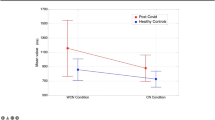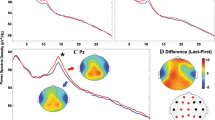Abstract
The aim of this study is to assess the ability of EEG-based indices in providing relevant information about cognitive engagement level during the execution of a clinical sustained attention (SA) test in healthy volunteers and DAI (diffused axonal injury)-affected patients. We computed three continuous power-based engagement indices (P β /P α , 1/P α , and P β / (P α + P θ )) from EEG recordings in a control group (n = 7) and seven DAI-affected patients executing a 10-min Conners’ “not-X” continuous performance test (CPT). A correlation analysis was performed in order to investigate the existence of relations between the EEG metrics and behavioral parameters in both the populations. P β /P α and 1/P α indices were found to be correlated with reaction times in both groups while P β / (P α + P θ ) and P β /P α also correlated with the errors rate for DAI patients. In line with previous studies, time course fluctuations revealed a first strong decrease of attention after 2 min from the beginning of the test and a final fading at the end. Our results provide evidence that EEG-derived indices extraction and evaluation during SA tasks are helpful in the assessment of attention level in healthy subjects and DAI patients, offering motivations for including EEG monitoring in cognitive rehabilitation practice.

Three EEG-derived indices were computed from four electrodes montages in a population of seven healthy volunteers and a group of seven DAI-affected patients. Results show a significant correlation between the time course of the indices and behavioral parameters, thus demonstrating their usefulness in monitoring mental engagement level during a sustained attention task.






Similar content being viewed by others
References
Petersen SE, Posner MI (2012) The attention system of the human brain: 20 years after. Annu Rev Neurosci 35:73–89. https://doi.org/10.1146/annurev-neuro-062111-150525
Pope AT, Bogart EH, Bartolome DS (1995) Biocybernetic system evaluates indices of operator engagement in automated task. Biol Psychol 40:187–195. https://doi.org/10.1016/0301-0511(95)05116-3
Freeman FG, Mikulka PJ, Prinzel LJ, Scerbo MW (1999) Evaluation of an adaptive automation system using three EEG indices with a visual tracking task. Biol Psychol 50:61–76. https://doi.org/10.1016/S0301-0511(99)00002-2
Oken BS, Salinsky MC, Elsas SM (2006) Vigilance, alertness, or sustained attention: physiological basis and measurement. Clin Neurophysiol 117:1885–1901. https://doi.org/10.1016/j.clinph.2006.01.017
Molteni E, Bianchi AM, Butti M et al (2008) Combined behavioral and EEG power analysis in DAI improve accuracy in the assessment of sustained attention deficit. Ann Biomed Eng 36:1216–1227. https://doi.org/10.1007/s10439-008-9506-z
Fairclough SH, Ewing KC, Roberts J (2009) Measuring task engagement as an input to physiological computing. In: 3rd Int. Conf. Affect. Comput. Intell. Interact. Workshop 2009 ACII 2009. pp 1–9
Dissanayaka C, Ben-Simon E, Gruberger M et al (2015) Comparison between human awake, meditation and drowsiness EEG activities based on directed transfer function and MVDR coherence methods. Med Biol Eng Comput 53:599–607. https://doi.org/10.1007/s11517-015-1272-0
Szafir D, Mutlu B (2012) Pay attention!: designing adaptive agents that monitor and improve user engagement. In: Proc. SIGCHI Conf. Hum. Factors Comput. Syst. ACM, New York, pp 11–20
Andujar M, Gilbert JE (2013) Let’s learn!: enhancing user’s engagement levels through passive brain-computer interfaces. In: CHI 13 Ext. Abstr. Hum. Factors Comput. Syst. ACM, New York, pp 703–708
Vecchiato G, Toppi J, Astolfi L et al (2011) Spectral EEG frontal asymmetries correlate with the experienced pleasantness of TV commercial advertisements. Med Biol Eng Comput 49:579–583. https://doi.org/10.1007/s11517-011-0747-x
Berka C, Levendowski DJ, Lumicao MN et al (2007) EEG correlates of task engagement and mental workload in vigilance, learning, and memory tasks. Aviat Space Environ Med 78:B231–B244
Chaouachi M, Frasson C (2010) Exploring the relationship between learner EEG mental engagement and affect. In: Aleven V, Kay J, Mostow J (eds) Intell. Tutoring Syst. Springer, Berlin; Heidelberg, pp 291–293
Gevins A, Smith ME, Leong H et al (1998) Monitoring working memory load during computer-based tasks with EEG pattern recognition methods. Hum Factors 40:79–91
Molteni E, Bianchi AM, Butti M et al (2007) Analysis of the dynamical behaviour of the EEG rhythms during a test of sustained attention. Conf Proc Annu Int Conf IEEE Eng Med Biol Soc IEEE Eng Med Biol Soc Annu Conf 2007:1298–1301. https://doi.org/10.1109/IEMBS.2007.4352535
Chuang S-W, Ko L-W, Lin Y-P et al (2012) Co-modulatory spectral changes in independent brain processes are correlated with task performance. NeuroImage 62:1469–1477. https://doi.org/10.1016/j.neuroimage.2012.05.035
Dockree PM, Kelly SP, Foxe JJ et al (2007) Optimal sustained attention is linked to the spectral content of background EEG activity: greater ongoing tonic alpha (approximately 10 Hz) power supports successful phasic goal activation. Eur J Neurosci 25:900–907. https://doi.org/10.1111/j.1460-9568.2007.05324.x
Gomez-Pilar J, Corralejo R, Nicolas-Alonso LF et al (2016) Neurofeedback training with a motor imagery-based BCI: neurocognitive improvements and EEG changes in the elderly. Med Biol Eng Comput 54:1655–1666. https://doi.org/10.1007/s11517-016-1454-4
Butti M, Pastori A, Merzagora A et al (2006) Multimodal analysis of a sustained attention protocol: continuous performance test assessed with near infrared spectroscopy and EEG. Conf Proc Annu Int Conf IEEE Eng Med Biol Soc IEEE Eng Med Biol Soc Annu Conf 1:1040–1043. https://doi.org/10.1109/IEMBS.2006.260493
Gray HM, Ambady N, Lowenthal WT, Deldin P (2004) P300 as an index of attention to self-relevant stimuli. J Exp Soc Psychol 40:216–224. https://doi.org/10.1016/S0022-1031(03)00092-1
Miniussi C, Wilding EL, Coull JT, Nobre AC (1999) Orienting attention in time. Modulation of brain potentials. Brain J Neurol 122(Pt 8):1507–1518
Warraich Z, Kleim JA (2010) Neural plasticity: the biological substrate for neurorehabilitation. PM R 2:S208–S219. https://doi.org/10.1016/j.pmrj.2010.10.016
Bonnelle V, Leech R, Kinnunen KM et al (2011) Default mode network connectivity predicts sustained attention deficits after traumatic brain injury. J Neurosci 31:13442–13451. https://doi.org/10.1523/JNEUROSCI.1163-11.2011
Li X-Y, Feng D-F (2009) Diffuse axonal injury: novel insights into detection and treatment. J Clin Neurosci 16:614–619. https://doi.org/10.1016/j.jocn.2008.08.005
Zoccolotti P, Matano A, Deloche G et al (2000) Patterns of attentional impairment following closed head injury: a collaborative European study. Cortex 36:93–107. https://doi.org/10.1016/S0010-9452(08)70839-6
Dockree PM, Bellgrove MA, O’Keeffe FM et al (2006) Sustained attention in traumatic brain injury (TBI) and healthy controls: enhanced sensitivity with dual-task load. Exp Brain Res 168:218–229
Gentilini M, Nichelli P, Schoenhuber R et al (1985) Neuropsychological evaluation of mild head injury. J Neurol Neurosurg Psychiatry 48:137–140
Scheid R, Walther K, Guthke T et al (2006) Cognitive sequelae of diffuse axonal injury. Arch Neurol 63:418–424. https://doi.org/10.1001/archneur.63.3.418
Homack S, Riccio CA (2006) Conners’ continuous performance test (2nd ed.; CCPT-II). J Atten Disord 9:556–558. https://doi.org/10.1177/1087054705283578
Conners CK, Epstein JN, Angold A, Klaric J (2003) Continuous performance test performance in a normative epidemiological sample. J Abnorm Child Psychol 31:555–562. https://doi.org/10.1023/A:1025457300409
Delorme A, Makeig S (2004) EEGLAB: an open source toolbox for analysis of single-trial EEG dynamics including independent component analysis. J Neurosci Methods 134:9–21. https://doi.org/10.1016/j.jneumeth.2003.10.009
Isaksson A, Wennberg A, Zetterberg LH (1981) Computer analysis of EEG signals with parametric models. Proc IEEE 69:451–461. https://doi.org/10.1109/PROC.1981.11988
Baselli G, Porta A, Rimoldi O et al (1997) Spectral decomposition in multichannel recordings based on multivariate parametric identification. IEEE Trans Biomed Eng 44:1092–1101. https://doi.org/10.1109/10.641336
Zetterberg LH (1979) Estimation of parameters for a linear difference equation with application to EEG analysis. Math Biosci 5:227–275. https://doi.org/10.1016/0025-5564(69)90044-3
Freeman FG, Mikulka PJ, Scerbo MW et al (2000) Evaluation of a psychophysiologically controlled adaptive automation system, using performance on a tracking task. Appl Psychophysiol Biofeedback 25:103–115. https://doi.org/10.1023/A:1009566809021
Sarter M, Givens B, Bruno JP (2001) The cognitive neuroscience of sustained attention: where top-down meets bottom-up. Brain Res Rev 35:146–160. https://doi.org/10.1016/S0165-0173(01)00044-3
Galán FC, Beal CR (2012) EEG estimates of engagement and cognitive workload predict math problem solving outcomes. In: Masthoff J, Mobasher B, Desmarais MC, Nkambou R (eds) User model. Adapt. Pers. Springer, Berlin Heidelberg, pp 51–62
Benjamini Y, Yekutieli D (2001) The control of the false discovery rate in multiple testing under dependency. Ann Stat 29:1165–1188. https://doi.org/10.1214/aos/1013699998
Szafir D, Mutlu B (2013) ARTFul: Adaptive Review Technology for Flipped Learning. In: Proc. SIGCHI Conf. Hum. Factors Comput. Syst. ACM, New York, pp 1001–1010
Huang J, Yu C, Wang Y, et al (2014) FOCUS: enhancing children’s engagement in reading by using contextual BCI training sessions. In: Proc. 32Nd Annu. ACM Conf. Hum. Factors Comput. Syst. ACM, New York, NY, USA, pp 1905–1908
Posner MI, Petersen SE (1990) The attention system of the human brain. Annu Rev Neurosci 13:25–42. https://doi.org/10.1146/annurev.ne.13.030190.000325
Holm A, Lukander K, Korpela J et al (2009) Estimating brain load from the EEG. Sci World J 9:639–651. https://doi.org/10.1100/tsw.2009.83
Pfurtscheller G, Lopes da Silva FH (1999) Event-related EEG/MEG synchronization and desynchronization: basic principles. Clin Neurophysiol Off J Int Fed Clin Neurophysiol 110:1842–1857
Bazanova OM, Vernon D (2014) Interpreting EEG alpha activity. Neurosci Biobehav Rev 44:94–110. https://doi.org/10.1016/j.neubiorev.2013.05.007
Egner T, Gruzelier JH (2004) EEG biofeedback of low beta band components: frequency-specific effects on variables of attention and event-related brain potentials. Clin Neurophysiol 115:131–139. https://doi.org/10.1016/S1388-2457(03)00353-5
Gola M, Magnuski M, Szumska I, Wróbel A (2013) EEG beta band activity is related to attention and attentional deficits in the visual performance of elderly subjects. Int J Psychophysiol 89:334–341. https://doi.org/10.1016/j.ijpsycho.2013.05.007
Gola M, Kamiński J, Brzezicka A, Wróbel A (2012) β band oscillations as a correlate of alertness—changes in aging. Int J Psychophysiol 85:62–67. https://doi.org/10.1016/j.ijpsycho.2011.09.001
Keller I (2001) Neurofeedback therapy of attention deficits in patients with traumatic brain injury. J Neurother 5:19–32. https://doi.org/10.1300/J184v05n01_03
Tana MG, Montin E, Cerutti S, Bianchi AM (2010) Exploring cortical attentional system by using fMRI During a continuous perfomance test. Intell Neurosci 2010:3:3–3:3. https://doi.org/10.1155/2010/329213
Dockree PM, Kelly SP, Roche RA et al (2004) Behavioural and physiological impairments of sustained attention after traumatic brain injury. Cogn Brain Res 20:403–414
Stathopoulou S, Lubar JF (2004) EEG changes in traumatic brain injured patients after cognitive rehabilitation. J Neurother 8:21–51. https://doi.org/10.1300/J184v08n02_03
Sullivan GM, Feinn R (2012) Using effect size—or why the P value is not enough. J Grad Med Educ 4:279–282. https://doi.org/10.4300/JGME-D-12-00156.1
Acknowledgments
The present research was partially funded by the THINK&GO (POR FSE 2007/2013) project and ARTE project supported by Regione Lombardia and Fondazione Cariplo.
Author information
Authors and Affiliations
Corresponding author
Rights and permissions
About this article
Cite this article
Coelli, S., Barbieri, R., Reni, G. et al. EEG indices correlate with sustained attention performance in patients affected by diffuse axonal injury. Med Biol Eng Comput 56, 991–1001 (2018). https://doi.org/10.1007/s11517-017-1744-5
Received:
Accepted:
Published:
Issue Date:
DOI: https://doi.org/10.1007/s11517-017-1744-5




